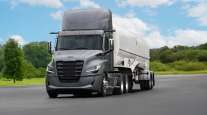Daimler Unveils Design of Future Truck 2025

The autonomous-driving truck from Mercedes-Benz offers twists on traditional features, including replacing rearview mirrors with a video-camera system and placing the headlights beneath the hood so they shine through the paint.
“I have driven more than one car onto the stage, but this night was a very special night for me because it was the first time I was driven on stage,” said Wolfgang Bernhard, president of Daimler’s global truck unit and former head of the Mercedes-Benz passenger cars unit.
PHOTO GALLERY: Future Truck 2025
The Sept. 22 event was held in an airline hangar at the Hanover airport, and included more than 500 guests from more than 30 countries. It took place before the start of the IAA Commercial Vehicles show.
“That is what our truck has in common with all those airplanes out there at the airport,” he said. “Both things can run on autopilot.”
Shortly after the program began, Bernhard was shown on video screens traveling in the truck.
After about one minute in the autonomous-driving mode, he took control of the vehicle during the final stretch and maneuvered it inside the hangar.
At the premiere in July outside of Berlin, the focus was on the communication systems, sensors and cameras that allowed the truck to utilize “Highway Pilot” to safely guide it around other vehicles and hazards at highway speeds.
The trucker remained in the driver seat at all times but was able to shift his seat 45 degrees, allowing him to work on his tablet or just relax.
During that event, many of the features of the truck cab were disguised. At the Sept. 22 event, however, the emphasis was on external and internal design features.
Besides the change in the look of the headlights, they are programmed to shine white when in manual-driving mode and pulsate blue when in autonomous mode.
In addition, LED lights replace traditional turn signals.
“We think it is cool,” Bernhard said in summing up the front end of the Future Truck.
The camera system that replaces side mirrors improves safety and increases night visibility with wide-angle video images that are displayed inside the cab, Bernhard said.
He added removing the mirrors has been proven to improve fuel efficiency.
Also along the side of the vehicle, radar sensors installed near the rear axle offer blind-spot assist technology.
As for the “visionary” trailer, Bernhard said there is 18% less aero resistance, which is due in large part to special rear-end flaps.
He acknowledged the flaps are not yet legal in many countries but said he expects that to change in the coming years.
Inside the Future Truck, the sleeper berth has been raised and the middle console has been removed.
A lounge chair replaces the passenger seat, and the dashboard has been condensed to a simpler instrument panel and a tablet.
Several Daimler officials said the interior offers truckers a more conducive workspace and living room.
Stay with ttnews.com all week, and pick up the Sept. 29 issue of Transport Topics, for additional IAA coverage, and follow @NeilAbt on Twitter.




